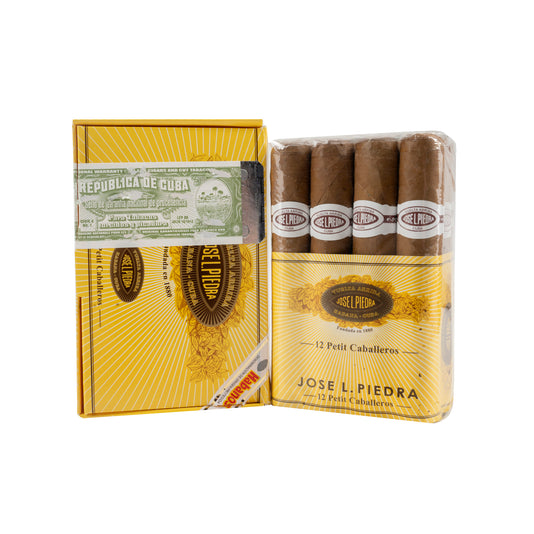
Filter
José L. Piedra Cigars
There are a few factors which set José L. Piedra apart from the rest of the Cuban cigar catalogue. While the overwhelming majority of tobacco used for Habanos comes from the legendary Vuelta Abajo region, Piedra cigars use the tobacco from the Vuelta Arriba area their founder first settled in. Almost all of their counterparts from the 26 other brands are made using Tripa Larga (long filler tobacco) while Piedra uses Tripa Corta (short filler tobacco). These differences serve to offer a wonderful expression of the Havana cigar experience, allowing regular smokers to expand their knowledge and new smokers to begin their journey at an amazingly accessible...READ MORE
José L. Piedra Cigars
There are a few factors which set José L. Piedra apart from the rest of the Cuban cigar catalogue. While the overwhelming majority of tobacco used for Habanos comes from the legendary Vuelta Abajo region, Piedra cigars use the tobacco from the Vuelta Arriba area their founder first settled in. Almost all of their counterparts from the 26 other brands are made using Tripa Larga (long filler tobacco) while Piedra uses Tripa Corta (short filler tobacco). These differences serve to offer a wonderful expression of the Havana cigar experience, allowing regular smokers to expand their knowledge and new smokers to begin their journey at an amazingly accessible price point. José L. Piedra have always been proud to be different.
When the founder made his way to Cuba from Asturias in Spain towards the end of the 19th century, conventional wisdom was that Havana was the place to be, and that the fertile lands to the east of the capital were the place to profit from tobacco harvests. Piedra decided instead to head for Remedios, one of the oldest tobacco-growing regions in Cuba, and make his fortune his own way. Three generation of the family took care of the business in the years up to the Revolution, garnering particular success in the American market. Unfortunately, their reliance on this huge customer base was eventually their downfall, as the Embargo signed by President John F Kennedy saw their largest sales source reduced to zero overnight. Dark times fell across the Piedra brand, and production was ultimately shut down.
In 1996 the name was revived, and Piedra was positioned alongside Quintero cigars as being producers of affordable, machine-made cigars. In the early part of the 2000s this practice was halted, with all Cuban cigars reverting to being totally handmade, but these 2 brands kept their reputations for affordability. The initial line of only 3 cigars was expanded in 2007 and again in 2019, forming the Regular Production vitolario we have today. All Piedra sticks are Medium-to-Full strength and provide astounding value for money to smokers.
José L. Piedra Brevas: This 42 ring gauge by 5 ¼ inch corona is an excellent choice for the morning, as it will smoke for about 25 minutes and the creamy, earthy flavours pair wonderfully with coffee.
José L. Piedra Cazadores: At 6 inches, this is the longest cigar Piedra makes; at 43 ring gauge, it has a typical girth for the brand. Coronas are they style of this marca, and this long version will bring flavours of cream and coffee like the rest of the line, for a longer 40 minute duration.
José L. Piedra Petit Caballeros: From the longest to the thickest, the Petit Caballeros is 48 ring gauge – considerably wider than its siblings. The extra width allows for a greater number of leaves, meaning the flavours of the brand have more scope to blend and are expressed more completely. 4 ¾ inches of length mean we will find about 40 minutes of smoke from this stick, and the creamy and coffee characters of the blend will be accompanied by a greater concentration of cedar wood and spice. This is also the most recent addition to the vitolario, and marks a development in style for Piedra.
To have rebuilt from complete destitution to being one of the 27 brands chosen by Habanos to represent Cuba worldwide is an impressive feat from José L. Piedra. To do so using so many unfashionable techniques – short filler tobacco, Vuelta Arriba production, only slim ring gauges and an initial reliance on machines for the rebirth – is nothing short of astonishing. In 2022 the brand was afforded a slight rejuvenation by Habanos – gone are the simple brown-on-white paper bands which have been used for so many years, in their place a more luxurious glossy paper, coloured cream and printed with an enhanced version of the logo. Despite their reputation as low-cost smokes – a reputation which is well-deserved – Piedra are being brought up to the luxury standard aficionados around the world expect of Cuban cigars.
Thanks to a long history of doing things differently, José L. Piedra have managed to maintain a singular identity which no doubt influenced the decision to revive them after their collapse, and helps to keep them in the minds of smokers today. Like their cousins at Quintero and Vegueros, Piedra have succeeded in showing the world that the whole of Cuba, not just the capital and the farms around it, have the propensity to make magnificent cigars, and that while it possible (and oftentimes warranted) to spend vast sums of money on extremely high-end smokes, it is also perfectly feasible to make excellent quality cigars at prices everyone can afford. These three brands are classified as “Volume” in the Habanos strategy, because they offer exactly that: the opportunity for all smokers, regardless of budget, to buy high quality cigars at low and affordable prices.
Brand Founded: 1880s
Strength: Medium-to Full
Construction: Handmade, Tripa Corta
Continuous Production Cigars: 5
























